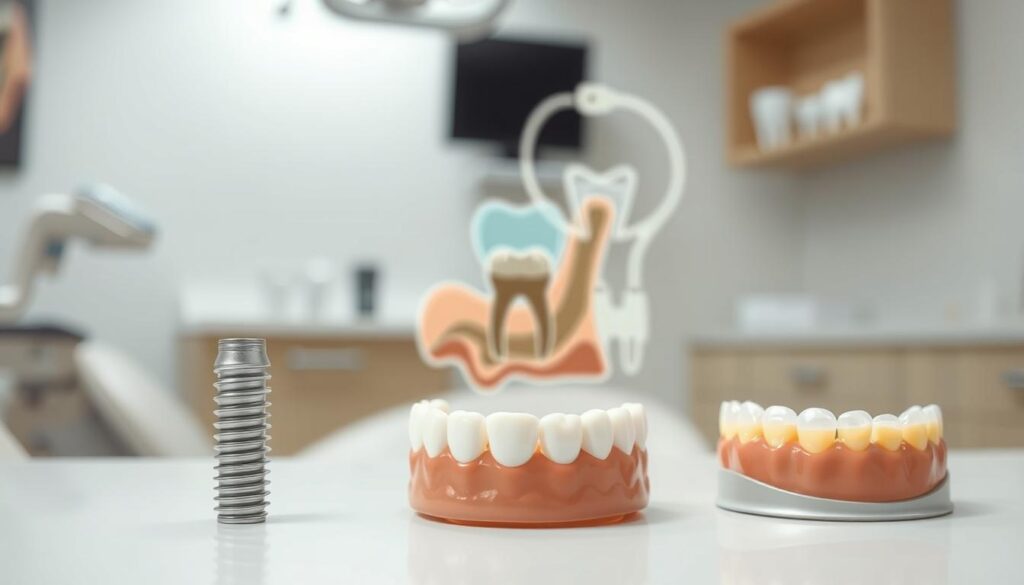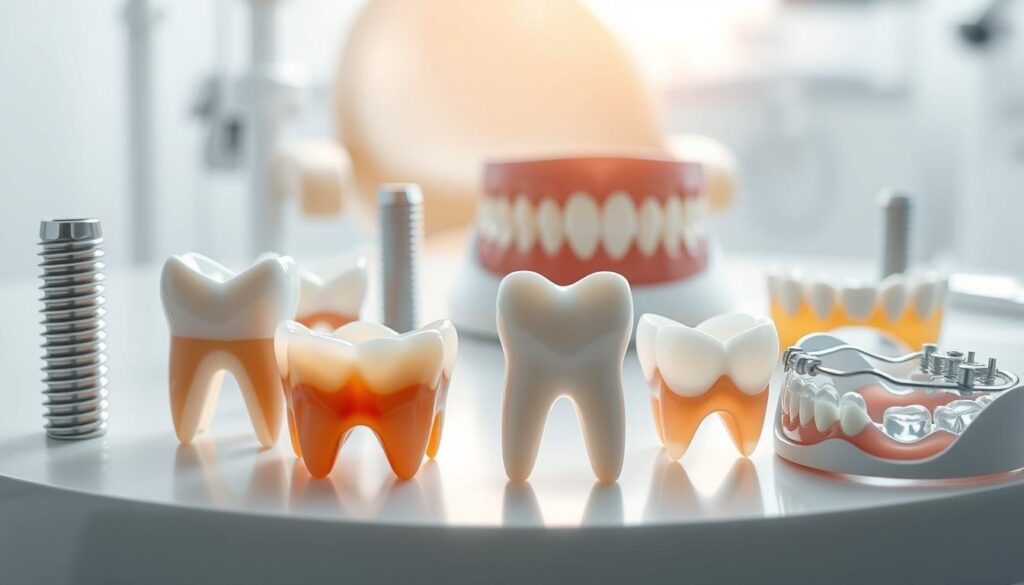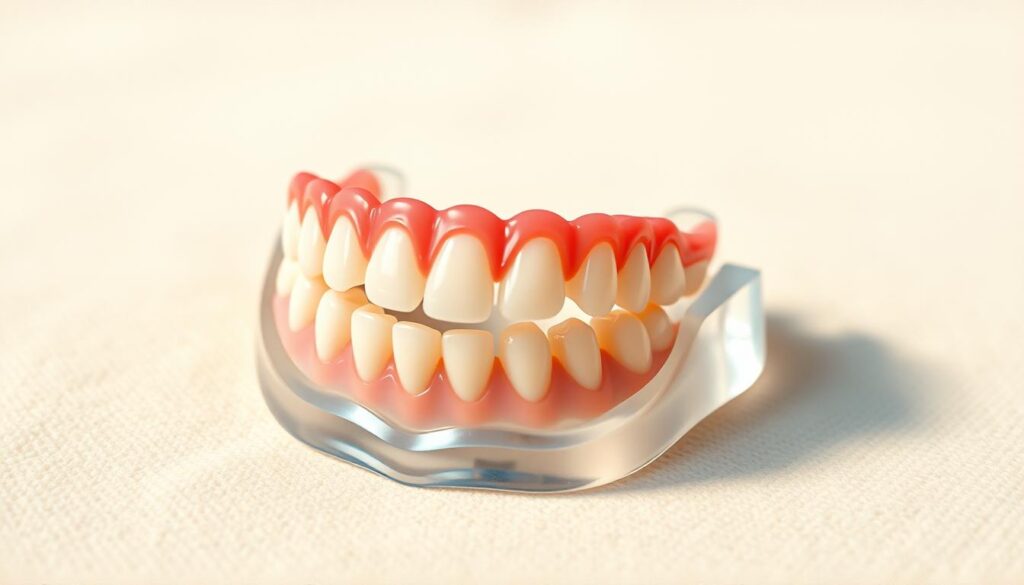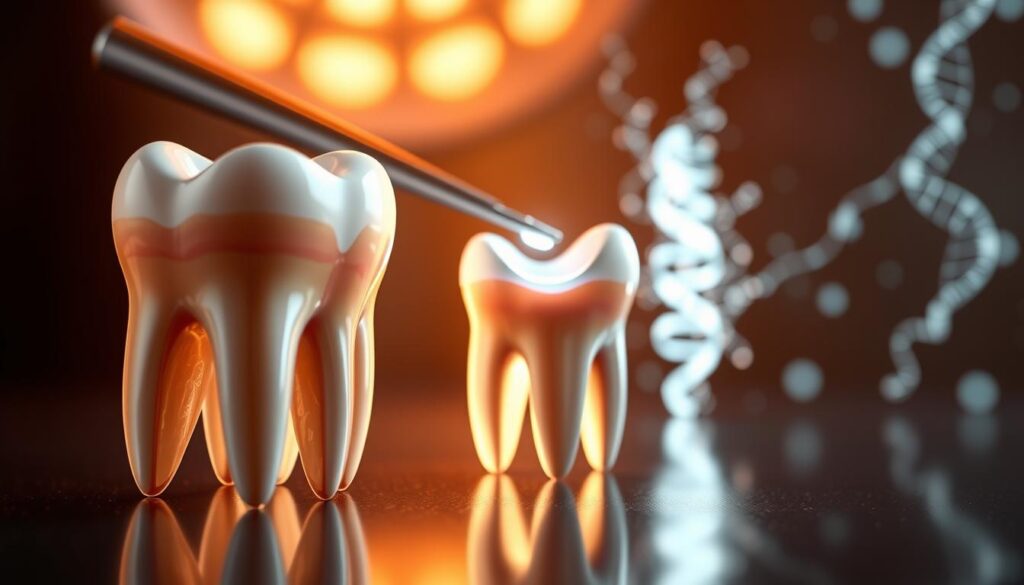What Are My Options to Replace a Missing Tooth?

Over 120 million adults in the United States have at least one missing tooth. This can make them feel less confident and make eating their favorite foods hard. The big question is: (What are my options to replace a missing tooth?).
Dentists say that even one missing tooth can affect how well you speak and your long-term oral health.
Experts in regenerative medicine are looking into new ways to fix this problem. They want to keep the jawbone strong and improve how well you can chew. Many are looking into (missing tooth replacement options) that could make eating and smiling easier again.
People wanting to learn more about fixing broken teeth can check out broken tooth repair. It has useful info on how to get your teeth back in top shape.
Key Takeaways
- Missing teeth affect appearance, speech, and chewing capacity
- Jawbone resorption often occurs when a tooth is lost
- Replacing a missing tooth can boost confidence and oral function
- Regenerative therapies hold promise for more natural solutions
- Cost, comfort, and longevity guide many treatment decisions
Understanding the Importance of Replacing Missing Teeth
More than 90% of adults between 20 to 64 have tooth decay. This often leads to losing part of a tooth. If left untreated, gaps can cause teeth to move and put pressure on the jaw. This can lead to more problems.

Impact on Oral Health
Teeth move towards gaps. This can mess up alignment and stress the jaw. It can also cause jaw pain and even wear out the jaw joint. Taking action early can prevent these issues.
Effects on Appearance
One missing tooth can change how your face looks. Gaps can make cheeks or lips look different. This can affect how you feel about yourself. Getting teeth replaced can help keep your face looking young.
Consequences for Speech and Eating
Missing teeth can change how you make sounds. You might have trouble saying “s,” “th,” and “f” clearly. Losing teeth also makes chewing harder. This can limit what you can eat and affect your nutrition.
Overview of Tooth Replacement Options
Many people look for good ways to deal with tooth loss. These options differ in how long they last, their cost, and how well they work. Before picking a solution, both doctors and patients think about what’s best for them.

Dental Implants
Dental implants are made of a titanium post that goes into the jawbone. They support a crown that looks like a real tooth. They can last for years. To keep them in good shape, you need to visit the dentist regularly and brush your teeth well.
Bridges
A bridge is attached to the teeth next to the gap. It’s a solid choice that doesn’t need surgery. Some bridges have metal frames and ceramic tops for a natural look. Taking good care of your teeth and bridge is important.
Partial and Full Dentures
Removable dentures are made of acrylic or composite materials. They can replace many or all missing teeth. New designs are thinner and more comfortable. You might need to get them adjusted often as your mouth changes.
Dental Implants: The Gold Standard
Many see implants as a top choice for decades. They offer a strong hold in the jaw, helping keep bone healthy. This stability is great for those wanting a natural feel and look.
Some ask if other options can match implants’ success. Yet, studies show implants are best when cared for properly.
What Are Dental Implants?
Implants involve a titanium or similar post in the jawbone. This post fuses with tissue, creating a solid base. An abutment connects it to a custom crown, making it look and work like a real tooth.
Benefits of Dental Implants
The main benefits are:
- They help keep gum and bone healthy
- They don’t harm nearby teeth much
- They make biting and chewing better
This design keeps the jawbone active, reducing bone loss risk over time.
The Process of Getting Dental Implants
First, an evaluation and imaging check if you’re a good fit. Then, a surgery places the implant. After that, a healing time lets it integrate well.
The final step is attaching the crown. This completes a secure and lasting tooth replacement. Each step is designed for stability and comfort.
Fixed Bridges: A Reliable Alternative
A solid bridge is a dependable way to replace a lost tooth. It looks real and works like your natural teeth. It fits well with the teeth around it.
It keeps your bite in line. It also protects the teeth next to the gap from moving.
What Is a Dental Bridge?
This prosthetic fills gaps where teeth are missing. It has crowns on each side that fit over healthy teeth or implants. You can choose from materials like porcelain or ceramic with metal.
How a Bridge Works
Bridges need support from anchoring units. Here’s how they work:
- Preparation of neighboring teeth
- Impressions for a custom fit
- Bonding the apparatus to reinforce stability
Pros and Cons of Bridges
Bridges offer quick results and look good. But, they might need to reshape nearby teeth. The bone under the gap might not get enough stimulation.
| Bridge Type | Composition | Main Benefit |
|---|---|---|
| Traditional | Metal with porcelain surface | Robust support |
| Cantilever | Ceramic or porcelain-fused | Suitable for specific single-sided gaps |
| Maryland | Metal framework | Minimal tooth alteration |
Partial Dentures: A Removable Solution
Many people look for a simple way to replace missing teeth. Partial dentures are a good choice. They can fill gaps in your mouth without needing a lot of surgery.
These dentures have metal clasps that hold onto your teeth. This makes them easy to fix if they get damaged. It’s a big plus compared to other options.

What Are Partial Dentures?
They are removable and use your teeth for support. They are made of strong acrylic and lightweight metal. This way, you can keep your healthy teeth and still have a full smile.
Advantages of Partial Dentures
These dentures are affordable and work well. Here are some of their best points:
- They don’t harm your other teeth much
- They’re easy to take out for cleaning
- They can be adjusted if your mouth changes
Caring for Partial Dentures
Keeping them clean is important for your health. Brush them gently and soak them in special solutions. Regular dentist visits help them fit right and avoid any discomfort.
| Feature | Description |
|---|---|
| Repair Flexibility | Often mended quickly without major procedures |
| Maintenance | Removed for thorough cleaning and routine checkups |
Full Dentures: When All Teeth Are Gone
Full dentures are a classic choice for those missing all their teeth. They cover the whole arch, giving support and confidence back. People often notice their face looks better and they can do everyday tasks more easily.
Understanding Full Dentures
These dentures sit on the gums and need to be made just right. They’re usually made of strong acrylic that fits your mouth perfectly. You might need to see your dentist now and then to keep them comfortable as your mouth changes.
Types of Full Dentures
Conventional dentures are placed after the gums heal. Immediate dentures are put in right after your teeth are removed. This way, you can leave the dentist’s office with your new teeth the same day. Both types might need some tweaks as your mouth adjusts.
Adjusting to Life with Full Dentures
Cleaning your dentures every day helps keep them free of food and plaque. Some people practice speaking to get used to how their dentures affect their voice. Getting them adjusted or repaired from time to time keeps them fitting well, helping you eat and speak better.
Stem Cell Therapy: A Cutting-Edge Option
Regenerative science is changing how we think about tooth replacement. Stem cells might grow into full teeth, avoiding problems with old prosthetics. This new area is exciting researchers.

What Is Stem Cell Therapy?
It’s a new method using special cells that can become different tissues. In dentistry, it aims to grow tooth structures. This could be a natural base for future fixes.
Potential Benefits for New Teeth
Regenerated teeth might solve issues with current implants. The benefits could be:
- Lower risk of implant problems
- Better fit with surrounding tissues
- Less chance of material rejection
Current Research and Developments
Top places like the National Institutes of Health are studying tooth growth. Early tests show hope for making real enamel and roots. As research goes on, a new way to replace teeth might become a reality.
Choosing Between Temporary and Permanent Solutions
When looking at missing tooth treatments, people often think about quick fixes versus long-term solutions. Options like flippers or transitional dentures can be a fast way to cover up a missing tooth. They’re great for those who need a quick solution for everyday looks.
Factors to Consider
There are several things to think about when choosing between temporary and permanent options:
- Time needed to make or install the solution
- The health of your bones and if you might need a graft
- Any current oral health issues that could impact the treatment’s success
Lifestyle Impact
Temporary fixes need regular cleaning and careful handling of food. Permanent solutions might give you more freedom with what you eat. But, they could require more complex procedures. Your daily habits play a big role in this decision.
Cost Considerations
Everyone’s budget is different, and insurance might not cover all treatments. It’s wise to talk to trusted dentists or visit specialized clinics for cost advice. Choosing the right treatment depends on your personal situation, maintenance needs, and comfort level.
The Role of Bone Health in Tooth Replacement
Having a strong jaw is key for lasting tooth replacements. A solid base helps implants stay in place and keeps other teeth stable. If your bones are weak, there are ways to add volume and support implants.
Importance of Jawbone Density
Strong bones hold artificial roots in place, allowing for normal chewing. Without natural teeth, bone loss can happen. Checking bone density early can prevent problems.
Solutions for Bone Loss
Ridge augmentation and sinus lifts can rebuild lost bone. These methods increase bone height or width, making room for implants. With the right plan, more people can get their smile back.
Bone Grafting Procedures
Different grafts are used, from the patient’s own bone to processed tissues. Healing times vary, depending on the graft and the patient’s body. Each method meets a specific need for a healthy jaw.
| Graft Type | Material Source | Common Use |
|---|---|---|
| Autograft | Patient’s own bone | Promotes quick compatibility |
| Allograft | Donated human tissue | Less invasive for the patient |
| Alloplastic | Synthetic materials | Reduces biological risks |
Oral Health Maintenance After Replacement
Keeping a new tooth replacement in good shape requires careful hygiene and watching for signs of trouble. Brushing and flossing regularly helps keep both real and fake teeth clean. Experts say getting professional cleanings every six months is key to good oral health.
Keeping Your Replacement Tooth Clean
Brushing every day helps protect your gums and stops bacteria from growing. Use a soft-bristle brush to clean around implants or under dentures gently but thoroughly. Some people find rinsing with a special mouthwash helps keep plaque away.
Regular Dentist Visits
Going to the dentist every six months is important. It lets them check how implants, bridges, or dentures are doing. This helps catch small problems before they get big, and makes sure everything fits right.
Handling Issues and Complications
If you feel pain or if something feels loose, see a dentist right away. Quick action can prevent infections and keep your mouth healthy. It also helps your replacement last longer, making everyday activities more comfortable.
Innovations in Tooth Replacement Technology
Dentistry is always getting better, offering care that’s more tailored and smooth. Digital tools make each step precise, leading to better results for patients. This resource shows how new methods are changing oral health.
New advancements focus on making things right, using better materials, and doing less harm. These changes mean more comfort, better looks, and function for those looking for modern tooth replacements.
3D Printing and Custom Solutions
Three-dimensional printing is changing dental work. Special printers make guides, crowns, and dentures with great detail. This means custom fits that look natural and need fewer changes.
Advanced Materials Used in Dentistry
Scientists are looking into new materials for tooth replacements. They’re finding ones that are strong, look real, and work well with the body. This makes recovery easier and helps smiles look healthier.
Future Trends in Tooth Replacement
Research is combining digital tech with new ways to grow tissue. This could lead to better implants and treatments. It shows a focus on making patients comfortable and getting the best results.
Emotional and Psychological Impacts
Seeing a gap in your smile can make you feel lost. This feeling can affect how you interact with others and see yourself. Talking to others who have gone through the same thing can help.
Confidence Boost from Replacement Options
Getting a stable tooth replacement can make you feel more confident. Studies show that people feel better about themselves when they have a full smile. This can help you trust your appearance again.
Dealing with the Loss of a Tooth
Missing a tooth can make you sad or frustrated. It can disrupt your daily life. Counseling can help you deal with the anxiety that comes with tooth loss. Mental health experts teach you how to cope positively.
Support Options Available
Joining community groups can make you feel less alone. Patient education programs teach you about teamwork in recovery. Sharing your journey with others can give you the support you need.
| Emotional Reactions | Helpful Solutions |
|---|---|
| Reduced Self-Esteem | Reliable Tooth Replacement |
| Stress or Anxiety | Counseling or Support Groups |
Cost of Tooth Replacement Options
When it comes to fixing teeth, money matters. People look for options that fit their budget and meet their needs. Each choice has its own price and long-term savings.
Average Costs of Different Options
Implants cost more upfront but can save money in the long run. Bridges are in the middle price-wise. Custom dentures are often cheaper at first but might need more upkeep later.
- Implants: May require surgical fees but can stay strong for decades
- Bridges: Generally cost less than implants yet might need replacement eventually
- Dentures: Carry lower starting fees but can involve periodic adjustments
Insurance Coverage Insights
Private dental insurance often helps pay for bridges or dentures up to a yearly limit. Medicare doesn’t always cover these costs, but some Medicare Advantage plans might help. It’s important to check your policy to know what you’ll pay out of pocket.
Financing Options and Plans
There are ways to pay for dental care over time. Dental schools and community health centers offer affordable options. They can make quality dental care more accessible.
Making the Right Choice for You
This final step combines clinical advice with personal goals. Every patient’s needs are unique. The best choice often starts with a detailed look at oral health and lifestyle.
A balanced approach can lead to results that look natural and feel secure.
Consulting with a Dental Professional
A thorough evaluation is key. Dentists use digital scans, X-rays, and medical histories to plan the best solution. In complex cases, referrals to specialists may be needed.
Regular checkups and open communication are crucial. They ensure each step of the process meets the patient’s comfort and safety.
Patient Testimonials and Experiences
Real-life stories shed light on the benefits of implants, bridges, or dentures. Many people feel more confident and enjoy social events more. Some find it easy to adapt, while others need time.
These experiences highlight the advantages of each option.
Evaluating Your Personal Preferences
Some prefer a low-maintenance option. Others consider cost, future adjustments, or recovery time. Understanding daily habits helps narrow the choice.
Each method has its benefits. Getting professional advice can help match those benefits with your long-term oral health goals and personal happiness.


